One of the most famous — and controversial — La Jolla attractions is our resident population of wild La Jolla seals and La Jolla sea lions. Unless the weather or surf keeps them away, they are almost always lounging or swimming along our stunning shoreline from the sea caves to the Children’s Pool and beyond.
I live in La Jolla and regularly visit these pinniped hangouts. I’m going to tell you in detail where the best viewing spots are (with a map), the best times to go, where to park, how to make the most out of your visit, what else you can do nearby, and why we’re one of the best places to see seals and sea lions in California.
Please give our seals and sea lions space! I promise you can enjoy them from a distance!
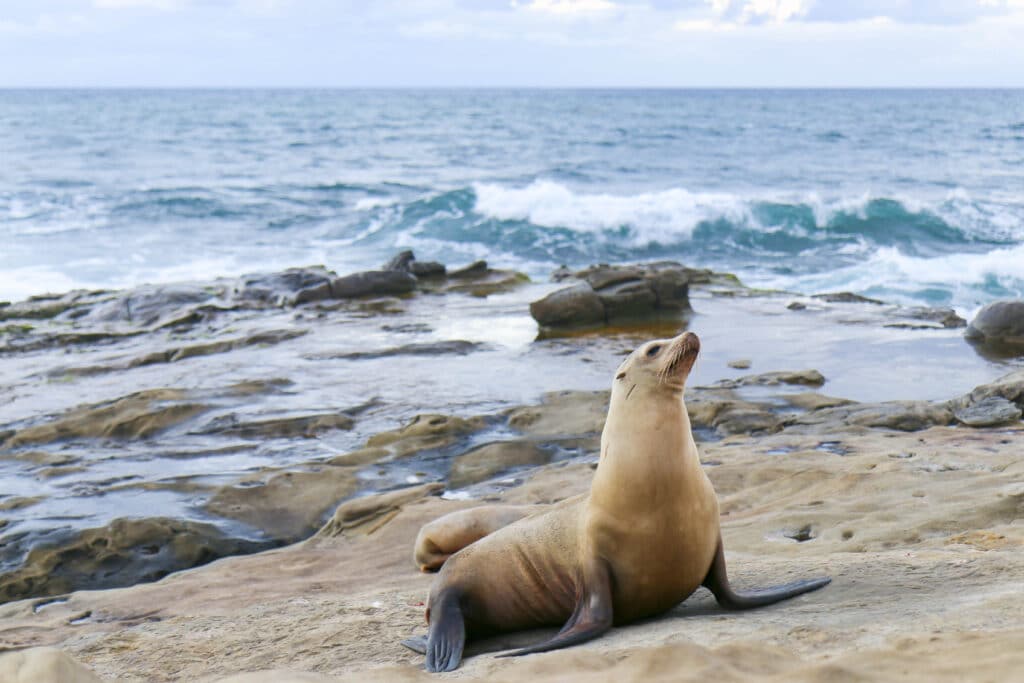
The Basics: Seal or Sea Lion?
La Jolla is home to both Pacific harbor seals and California sea lions. Let’s explore how to spot the difference between these two adorable marine mammals, as they share many features.

The most obvious difference between La Jolla seals and La Jolla sea lions is that sea lions have external ear flaps. This is the first thing I look for when watching them from a distance, although by now, I can usually tell by their size, coloring, and how they stand.
Sea Lion or Seal?
California Sea Lions
Pacific Harbor Seals
Sea lions also have larger and stronger flippers that allow them to “walk” and climb up cliffs, which is why they’re so visible on the bluffs of La Jolla Cove. Seals have smaller, webbed front flippers and move around on land by flopping around on their stomachs.
Sea lions are brown, and seals are darker gray, brown, or almost black with speckled skin. And if you hear barking, that’s a sea lion (usually a male). Seals are only capable of low grunts. Rest assured that you’ll hear both in La Jolla, but the sea lions win the award for most chatty.
Finally, seals are typically solitary animals, but you will see them in large groups here in La Jolla. Like BFFs, highly social California sea lions often pile up next to and on top of each other.
There is one outlier that you may spot though it’s rare. Elephant seals, who live abundantly in Northern California, have been spotted in La Jolla. Like harbor seals, they do not have external ear flaps, but you can not miss their giant noses. They also are quite large, triple the size of an average Pacific harbor seal.
Where to See La Jolla Seals and Sea Lions — 6 Points of Interest on Land

While you could see them anywhere along our coastline, the best place to see La Jolla seals and sea lions is along Coast Boulevard between The Cave Store in the north and Children’s Pool in the south.
This famous La Jolla seal and La Jolla sea lion coastal trail passes by several popular haul-out sites. (Hauling-out is when pinnipeds like seals and sea lions leave the water to breed or rest.) It’s about three-quarters of a mile long and would take roughly 15 minutes to walk without stopping.
You will stop multiple times, so plan for at least an hour. Bring your camera because the views are stunning. Many of my pinniped pictures are taken with a zoom lens, which I recommend you bring.
Hopefully, this illustrated map will showcase how easy it is to explore our California sea lion and seal beaches. Where you start is completely up to you and can also be determined by where you find parking (more on how to park below). There is no right or wrong place to start or stop.
The map also points to the trailhead for Coast Walk Trail next to The Cave Store. You can walk the Coast Walk Trail about a half-mile to La Jolla Shores. You will see and hear sea lions and some seals below the La Jolla cliffs here.
However, due to time constraints, I find that most tourists stick to the paved route between The Cave Store and Children’s Pool Beach.
1. The Cave Store and Sea Caves Area

La Jolla is home to seven sea caves. If you park near The Cave Store, You can walk into Sunny Jim Sea Cave (admission is required, and it takes just a few minutes to see it).
It’s the only sea cave in California that is accessible by land. Inside the store, you’ll walk down a sometimes slippery staircase (so be careful with small kids in tow) to a platform inside of the cave. Chatty sea lions will occasionally be lounging inside Sunny Jim Sea Cave or swimming nearby. The echo of their barks in the cave can be loud and neat for kids to hear.
Not long ago, a sea lion pup climbed the stairs into The Cave Store to “browse around.” If you’re short on time, this side excursion isn’t necessary but should only take about 20 minutes from start to finish.
Clam’s Cave, steps from The Cave Store to the south, is La Jolla’s only sea cave visible from land. Here you may see California sea lions swimming and lounging in the distance.
Goldfish Point is a viewing area (the wooden platform and walkway are not pictured in the photo above) on the top of Clam’s Cave and can be accessed from the boardwalk. The views are spectacular from the point, and it’s a pretty spot for pictures as you’ll no doubt see people kayaking, snorkeling, and scuba diving in the La Jolla Underwater Park below. Stay on the path; nothing protects you or small kids from the edge if you leave it.
If you don’t see or hear any seals or sea lions in this area (rare), keep walking toward La Jolla Cove, where a bonanza of sea lions awaits.
You can’t miss them. You might smell them first, which is part of why our marine mammal residents are controversial.
2. La Jolla Cove

Sea lions live at La Jolla Cove and are mistakenly called La Jolla Cove seals. I walk here quite a bit and have never seen a harbor seal here.
La Jolla Cove is a small cove beach flanked by two rocky points where sea lions love to sunbathe. The north point, which you’ll reach first if headed south from the sea caves, is accessible by a gate. Here, you can step out onto the rocks for scenic photos. I personally think this area is a bit slippery for younger kids but fine for older kids.
When you’re finished here, keep walking to the stairway leading to La Jolla Cove beach. If the picturesque beach isn’t crowded, sea lions will often lounge on the sand. They also like to huddle on the rocks near the small cave on the beach’s south side.
Back up on the boardwalk, the coastal path will take you past the lifeguard tower to the southern rocky point, Point La Jolla, which helps divide La Jolla Cove from Boomer Beach. This is by far the best place to view sea lions.
However, people have been getting inappropriately close to the sea lions despite signage, chains blocking off the access stairs, and pleas from the city and locals. It’s infuriating.
STAY OFF POINT LA JOLLA
- The sea lions here appear to be used to people, but just because you can get quite close to them doesn’t mean you should. They are wild animals.
- Too many people violate their space during pupping season, especially. Starting in November 2023, Point La Jolla will be closed year-round.
- This is for the protection of the La Jolla sea lions and the public.
Trust me, you can see plenty from the boardwalk. From here, you can zoom in just fine with a phone or even better with a DSLR camera. If you want clearer photos, phone zoom lenses on Amazon can cost around $20.
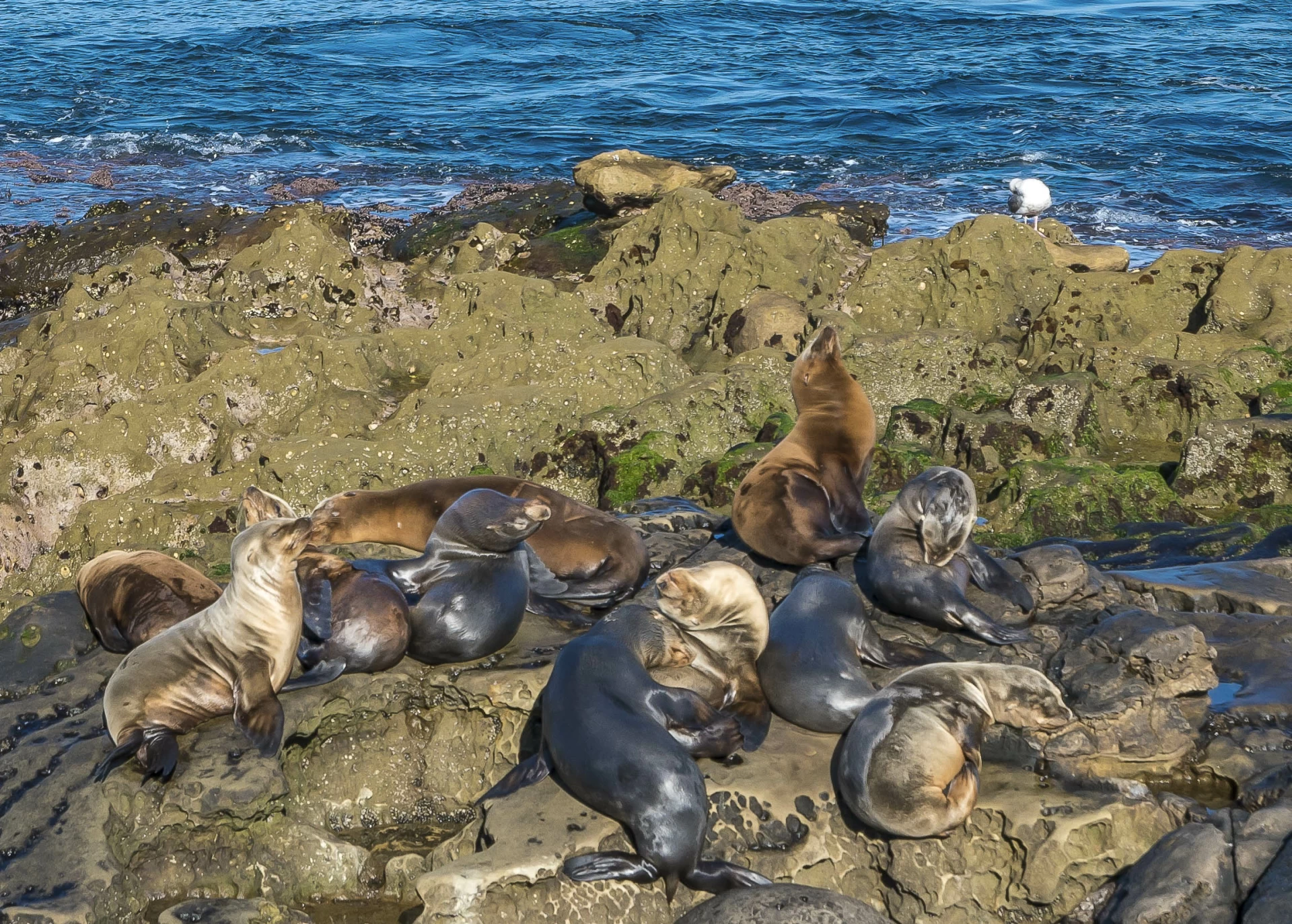
Tip: Ellen Browning Scripps Park is the big grassy area adjacent to La Jolla Cove, Boomer Beach, and Shell Beach. Feel free to picnic, lay out a blanket, fly a pocket kite, watch the sunset, or kick a ball around here.
3. Boomer Beach

Another sea lion hotspot is the sand directly south of Point La Jolla, an area called Boomer Beach.
I often see them sunbathing here or perhaps seeking respite from the chaos on the point. You also may see them frolicking in the shorebreak.
Boomer Beach is now closed alongside Point La Jolla to protect the La Jolla sea lions. I promise you that you will still be able to enjoy them from the boardwalk. I love watching them nap on the sand and play in the water here!
4. Shell Beach

Keep walking south, and you’ll pass a few of La Jolla’s famous belvederes or green huts.
As the walkway curves east, you’ll see an access point to Shell Beach. The stunning beach is named for the cool tide pools that reveal themselves at low tide.
From here, you can see the Children’s Pool and Seal Rock, where our harbor seal colony hangs out. You might see seals and sea lions swimming in the water as they travel between the various haul-out points.
I don’t usually see seals or sea lions lounging on Shell Beach, but I’m sure they do.
5. Seal Rock
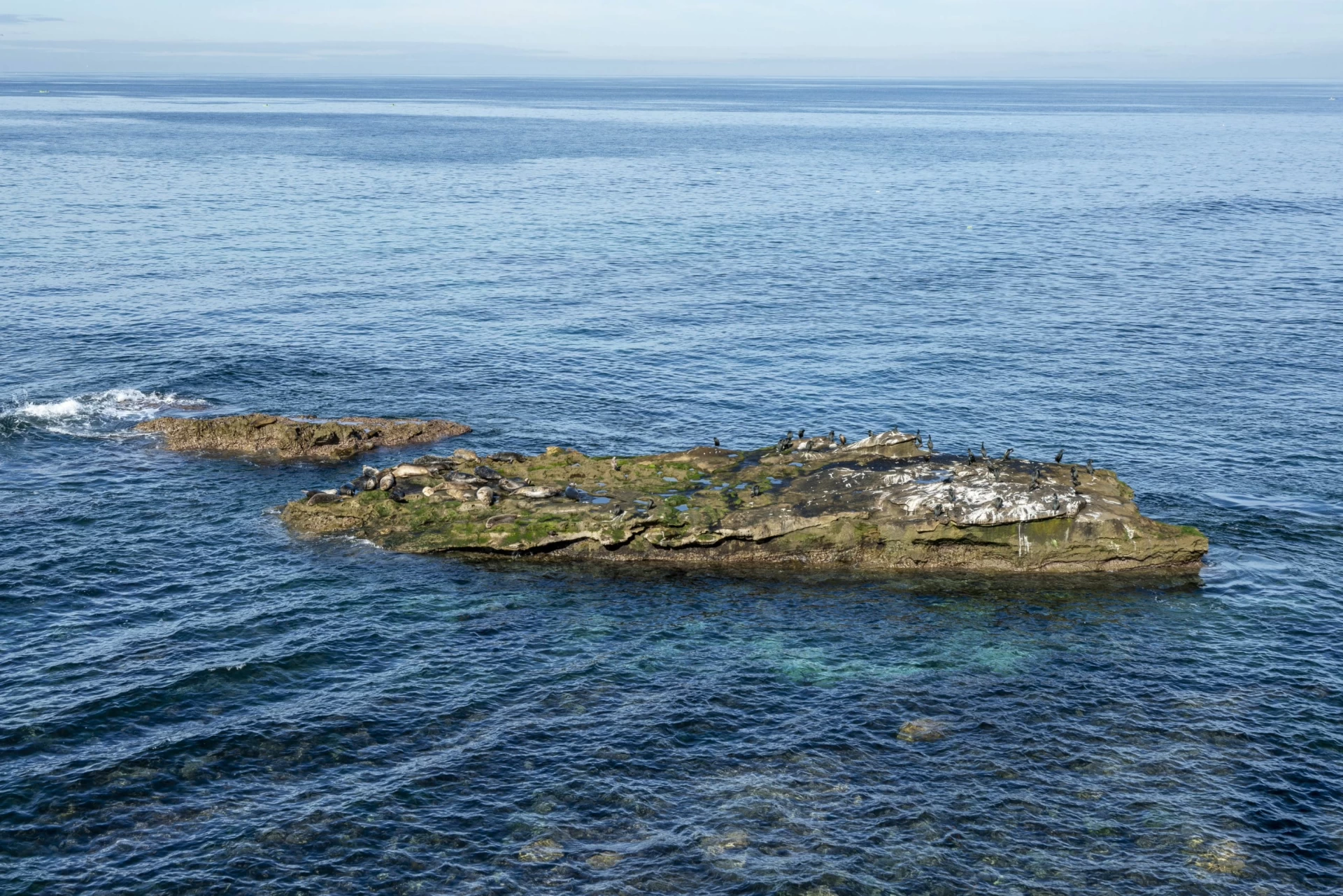
Google Maps tends to mark Seal Rock as located south of the Children’s Pool but rest assured that it’s between Shell Beach and Children’s Pool Beach. You’ll see it from the coastal path, as it usually looks like an island surrounded by water.
At really low tides, you can almost walk out to Seal Rock. Otherwise, it’s a haven for sea birds and our famous seals. Currents pull water over or near the rocks while its inhabitants relax — a cool sight to video if you’re lucky to see it.
6. Children’s Pool Beach
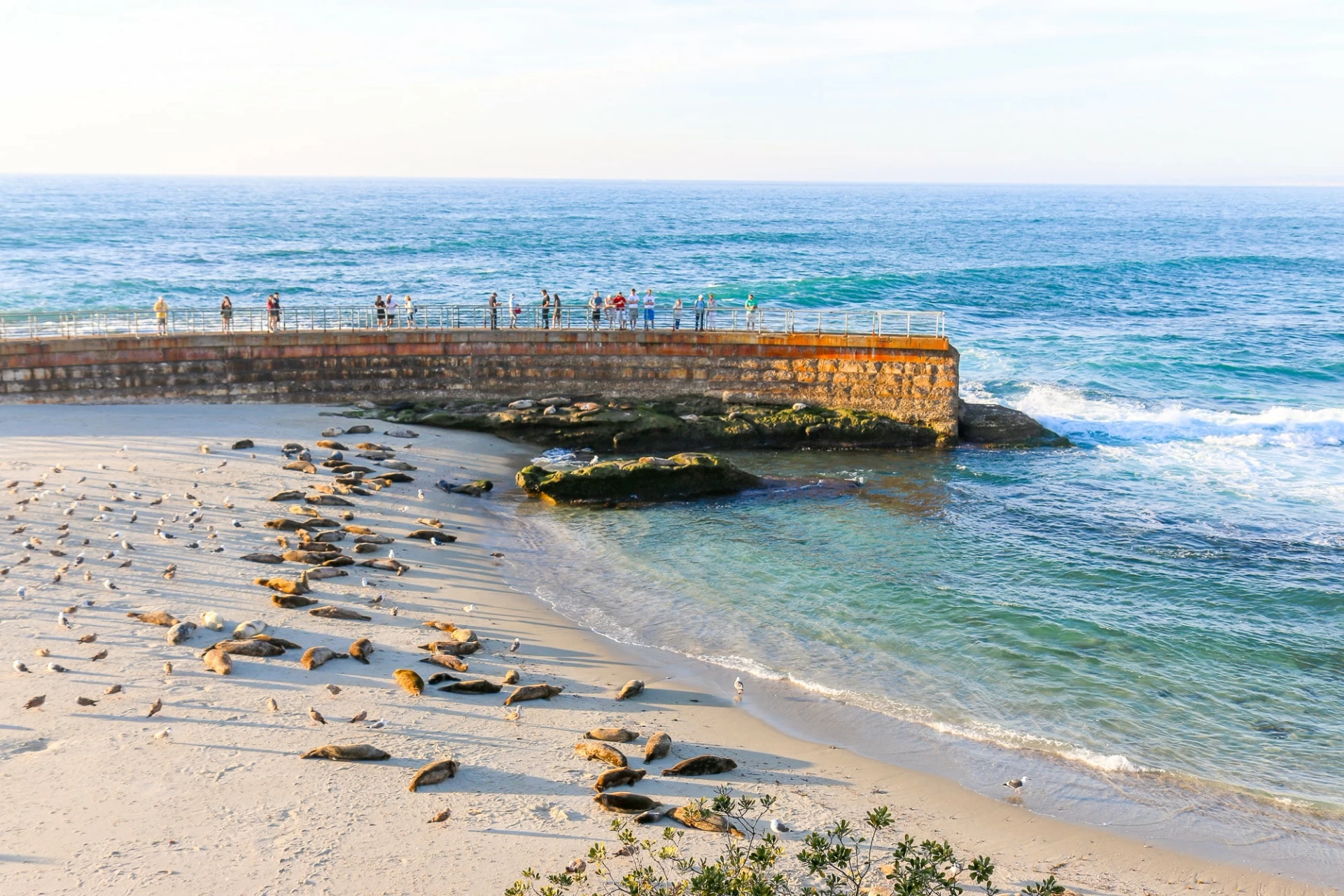
Your final destination (if you’re here to see seals and sea lions) will be the Children’s Pool Beach, otherwise known as Casa Beach or Seal Beach La Jolla.
A Quick History
Protected by a concrete sea wall built in the 1930s, the area was supposed to be a safe place for children to swim.
Over time, the area was filled with more sand than anticipated. The harbor seals gravitated toward the calm water here (especially during their pupping season) and have taken over the area — much to the dismay of some residents but to the delight of others.
Today It’s a Protected Rookery
Casa Beach is the only National Oceanic and Atmospheric (NOAA) recognized mainland harbor seal rookery between the U.S./Mexico Border and Ventura County. It isn’t common for harbor seals to haul out in an urban setting like this.
Conservationists say that wildlife protection laws like the Marine Mammal Protection Act (MMPA) gave precedence to the animals, while some residents would prefer that it was still a swimming spot.
In 2018, the California Court of Appeals upheld a policy that allowed the city to close the beach from December 15 through May 15 so the seals can have and rear their newborn pups mostly undisturbed. (You will not miss the lack of beach access as we have other sandy beaches to enjoy.)

During this pupping season, the small beach is closed to humans. You can view the seals and seal babies from the seawall when conditions permit (not an activity for very small children because it’s slippery) or from the boardwalk.
During the rest of the year, a rope barrier sections off part of the beach to protect the seals from humans who want to use the beach. During this season, you can swim here, but it’s usually not sanitary.
Kayaking, Swimming, Snorkeling, or Diving in the La Jolla Underwater Park

If you’d like to see La Jolla seals and sea lions from the water, head out into the San Diego-La Jolla Underwater Park. You can go on your own or book a variety of guided tours.
I’ve enjoyed a kayaking tour with Everyday California and highly recommend it for great exercise and a fun day out in our sunshine. Several social sea lions swam next to us as we paddled.
You can also take a kayak and snorkel tour combo. Or, take a snorkeling-only tour.
EXCLUSIVE EVERYDAY CALIFORNIA DISCOUNT (AD)
Use code LJMOM20 for a 20% discount on kayak and snorkeling tours, lessons, and rentals. Book now.
Scuba divers tend to explore independently, but you can look up some organized diving tours.
Bring an underwater camera as there are also Garibaldi, rays, and other marine life to see. Depending on your comfort level, some people call it lucky to take amazing footage of swimming alongside sea lions — but it doesn’t happen normally.
Best Time of Day to See La Jolla Seals & Sea Lions
In my experience, some La Jolla seals or sea lions are always out and about unless it’s raining or windy, or about to become stormy.
If the weather cooperates, I would be truly surprised if no one is home in any of these spots, but you never know, as nature can’t be controlled.
La Jolla Sea Lions
I’ve seen sea lions as early as 7 a.m. at the Cove and as late as after sundown. They tend to fish mid-day and may not be as abundant on land around lunchtime. I can’t think of a time lately when they haven’t been there.
When it is low tide, they usually hang out further from the boardwalk because more of Point La Jolla and other rocky areas further from the boardwalk become exposed.
Large rocks near the shoreline become little islands. The sea lions climb up on them to sunbathe, so there may be fewer on the shoreline.

However, winter low tides during daylight are among the best times to visit this area. That’s when the spectacular La Jolla tide pools become exposed. They are full of marine life, including sea stars, hermit crabs, octopuses (rare, but keep an eye out), and other creatures.
La Jolla Seals
The seals at Children’s Pool seem to come and go more often than the La Jolla Cove sea lions. Sometimes, none are on the beach (though they may be out on Seal Rock).
When it’s hot during the summer months, they’ll typically leave the beach by 8 a.m. — also because that’s when humans start to arrive.
They usually start to return when the sand cools down in the late afternoon and around sunset. Seals need a good amount of sleep, so if they’re out fishing on hot days, they return to recharge at the end of the day.

The time of year can matter, too. According to the La Jolla Seal Conservancy, you will see the most seals on the beach between the last week of April and the first week of June.
The greatest chance of seeing a live birth (yes, seal pups are born on the sand) is between February 4 and March 4.
Where to Find Parking
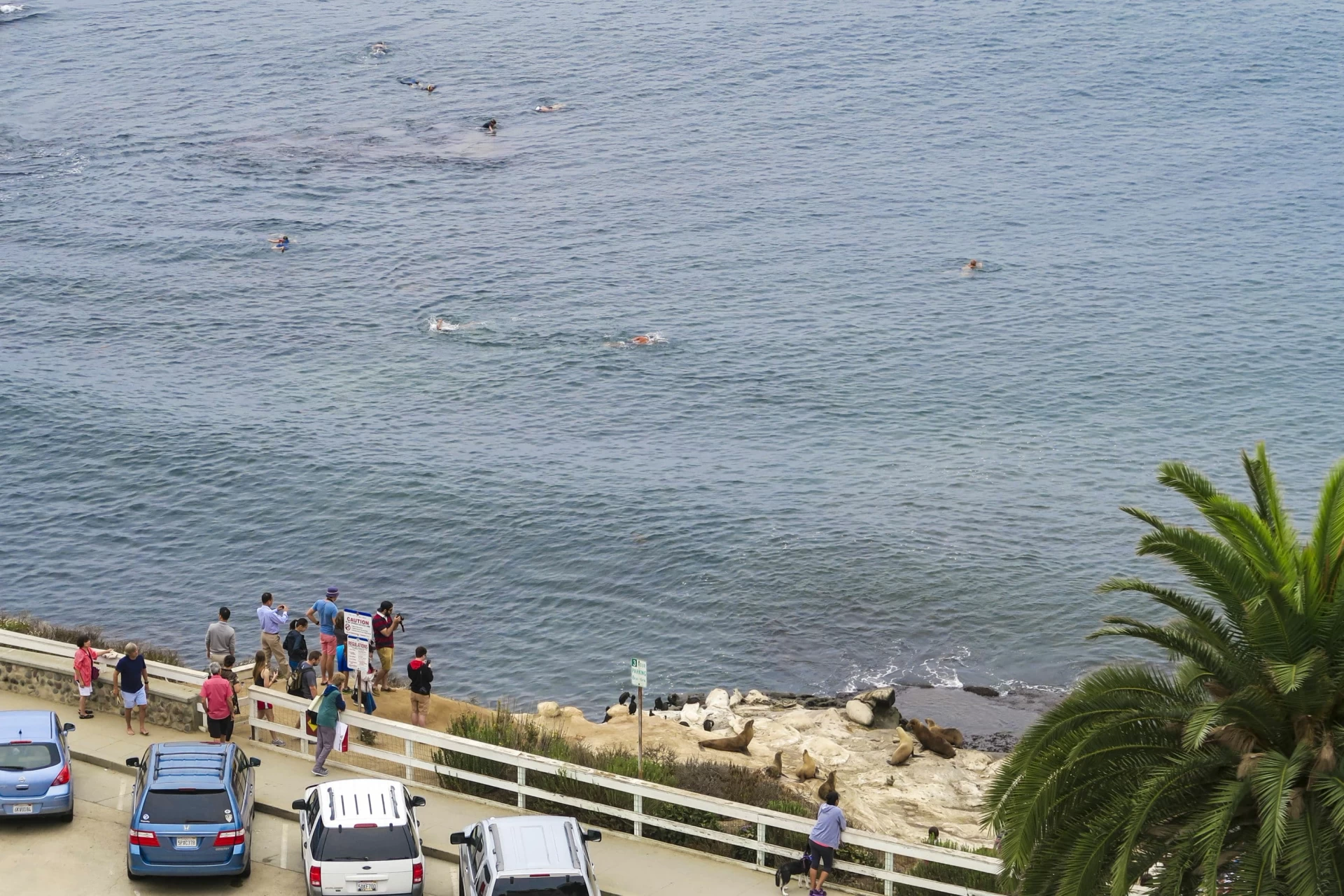
La Jolla’s Coast Boulevard runs along the shoreline from The Cave Store to Pearl Street, past the Children’s Pool.
Coast Boulevard street parking
Coast Blvd is the best place to park if you want to see the seals and sea lions, experience La Jolla Cove, walk the coastline, or enjoy a sunset from Ellen Browning Scripps Park.
It is also the most popular place to park. The time limit is 2 or 3 hours, depending on where on the street you are. We like to arrive early to secure 3-hour parking along the section of Coast Blvd, roughly between The Cave Store and La Jolla Cove. You’re most likely to grab a spot before 9 a.m. though you can get lucky at other times throughout the day.
You’ll need to access this part of Coast Blvd from Prospect Place, a one-way street. It’s a hassle to circle back to re-drive this section of Coast Blvd, so if you see a parking space on your first pass-through, snag it.
Timed Parking on other STreets
If 2- or 3-hour parking on Coast Blvd is full, and often it is, try parking on the side streets that run parallel to Coast Blvd that you’ll start to see as you reach Shell Beach (where Girard Avenue and Coast Blvd intersect). You can also head up to Prospect Street or Girard Street or park in one of the paid public lots.
Note that street parking on Prospect and the streets in the retail and restaurant area usually ranges from 1-2 hours. There’s a small strip on Prospect near the La Jolla Recreation Center, where it’s 4-hour street parking.
PAID PARKING LOTS
The closest paid public lot is in the La Jolla Financial Building at 1200 Prospect Street. You can search for other paid parking lots online.
You may also use La Jolla Valet at 1250 Prospect Street in front of George’s at the Cove if you arrive after it opens at 11 a.m. The latter is a flat rate of $13.20 all day (call to check as this price changes), which is a good deal if you don’t mind waiting for your car.
Tips for Visiting the La Jolla Seals and Sea Lions
If you will walk out onto the rocky areas (where permitted), wearing closed-toed shoes with traction that are easy to clean or washable is a good idea. Even when the rocks are dry, loose dirt on the rocks can make them slippery.

Avoid all brown puddles. While they can be mistaken for ocean water, they likely have sea lion waste. Yes, it smells, but you must remember that sea lion poop plays an important role in the underwater ecosystem by providing nitrogen for the nearby kelp forests.
It’s not a bad idea to keep a plastic bag in your car in addition to an extra pair of shoes just in case you accidentally step in a brown puddle — which does happen — but it’s not as likely these days with Point La Jolla closed. I’ve done it plenty of times, and even a small splash on your shoes can have your entire car smelling. It’s best to bag up these shoes.
MOST IMPORTANTLY, KEEP YOUR DISTANCE FROM SEALS AND SEA LIONS.
Please keep a respectful distance from our seals and sea lions. Far too many people are making the hazardous decision to stand, sit, take selfies (no selfie sticks, please), and place infants inches away from these gorgeous creatures.
This is not only incredibly dangerous for you and them, but it stresses them out unnecessarily. They are wild creatures and deserve to live undisturbed by nosy humans.

Bring a zoom lens for your camera instead. You could also bring a small pair of travel binoculars to see them swim.
Or, perhaps take a better look at seal pups on the sandy La Jolla beach from behind the rope barrier that protects them during pupping season. You don’t need anything to magnify your view. You’ll see plenty of cuteness while keeping your distance.

These sea lions and seals can bite and lunge toward you if you get too close, and they feel threatened. I know it’s hard to resist seeing them up close because they’re adorable and can sleep right next to the boardwalk, but please keep your distance.
These are not aggressive animals, but they will react if you infringe on their territory. Sharing respectfully is the most caring thing you can do for them and our community.
Please do not feed them. Tossing them food is not permitted. Our sea birds will likely pick it up, which isn’t good for them either. You may also not chase them, an act that is called flushing.
Feeding and flushing seals and sea lions are against the Marine Mammal Protection Act, as is any form of harassment or harm. You’ll be fined if you do either of these things.
Who to Contact in a Seal or Sea Lion Emergency
If you see a hurt or sick seal or sea lion, don’t intervene. Please call SeaWorld San Diego.
The SeaWorld San Diego marine mammal rescue number is 1-800-541-7325. I have it programmed into my phone as they can suffer from a lack of fish when El Niño warms up the waters, become injured by ocean debris and fishing gear, or look like they need help.
I have called SeaWorld San Diego a few times, and they do respond. You can also inform a lifeguard.
If you see a seal or sea lion being abused, contact a nearby lifeguard (they also will call SeaWorld about injured or sick marine mammals). Or, call the San Diego Police Department non-emergency line (if it is a true emergency, call 911) at 1-619-531-2000.
You can also call the National Oceanic and Atmospheric Administration (NOAA) Office of Law Enforcement at 1-800-853-1964. NOAA handles the abuse of marine mammals, including dolphins, sea turtles, whales, and others.
Resources for Nearby Restaurants, Shops, and Things to Do
There is much to do in the Village of La Jolla (also called Downtown La Jolla). My La Jolla Cove guide is a good place to start for more tips on what to do, where to eat, and more near the seals and sea lions.
These articles cover all of La Jolla and can be helpful as well:
- Where to Eat in La Jolla
- Best La Jolla Shopping
- Top things to do in La Jolla (and those that are free)
- Best Beaches in La Jolla
Viewing the seals and sea lions is also on my list of the best things to do in San Diego with kids. I adore them.
FAQs About Visiting La Jolla Seals and Sea Lions
Here is your pop quiz or TL;DR about how to see our pinnipeds.

Fun fact: Squid live in the underwater La Jolla Canyon. We have the largest annual aggregation of leopard sharks in La Jolla because they come to incubate their babies in our warm shallow water. Leopard sharks leave the shallow water at night to feed on squit in the La Jolla Canyon.
Why are there seals in La Jolla?
Seals and sea lions congregate here because they have easy access to our La Jolla Underwater Park Ecological Reserve, which is rich in marine life that lives among the sand flats, kelp forests, and submarine canyons.
The pinnipeds do not have to swim too far to feed. Harbor seals tend to eat small fish and shellfish. The larger sea lions eat small fish and small squid.
Are there Seals at La Jolla Cove?
No. The Pacific harbor seals that La Jolla is famous for live at Children’s Pool. However, the La Jolla Cove sea lions are sure to please. They’re larger, chattier, and nearly always lounging and playing on the rocks.
People mistakenly call them the La Jolla Cove seals, but they are not seals. We’re so lucky to have both pinnipeds.
Where are the sea lions in La Jolla?
You can see the La Jolla sea lions by the cliffs at La Jolla Cove and seals at the Children’s Pool (Casa Beach). However, you’ll see them in various spots on La Jolla beaches and swimming in the water.
Where are the seals in La Jolla?
The La Jolla seals are located at Children’s Pool Beach.
What types of seals are in La Jolla?
We have mostly Pacific harbor seals in La Jolla though people have spotted elephant seals.
Can you pet the seals at La Jolla Cove?
La Jolla Cove is mostly home to sea lions, and no, you can’t pet them. You also can not pet the harbor seals at the Children’s Pool. Please keep your distance even if you think that no one is watching.
Can you feed the La Jolla seals and sea lions?
No. It is against the Marine Mammal Protection Act to feed seals and sea lions. You may be fined if you are caught.
If I can’t get close to them, is it worth going?
YES. I can’t emphasize how much you will enjoy looking at our pinnipeds from the sidewalk. You are still pretty close to them, and they are usually in large numbers. The sea lions especially are active and chatty.
People sit on the wall or nearby benches and watch them for long stretches of time. It’s a peaceful scene with the ocean in the background, especially in nice weather.
Where else are there seals in San Diego?
Aside from the rookery at Children’s Pool Beach (Casa Beach), you can see our resident seal population in San Diego Bay and occasionally swimming in Mission Bay, in the southwest corner near where the bay lets into the ocean, and there aren’t motorized boats. But, they can be spotted randomly all up and down our coastline.
What is the best time of year to see the La Jolla Seals?
The best time of year to see the most seals in La Jolla is between the last week of April and the first week of June. If you want to try your luck at seeing a live seal birth (rare, but it does happen), time your visit between February and March.
Can I swim with sea Lions in La Jolla?
Technically yes. Some of our locals called them the dogs of the sea because they are somewhat used to humans and will approach you if interested. However, you should not seek them out or try to approach them for your safety and theirs because they are wild animals.
Where Else can I see sea lions in California?
One of the best places to see sea lions in California is La Jolla Cove (an excellent sea lion beach in California). However, they are all up and down the California coast.
Other places include San Simeon, the Channel Islands National Park and Marine Sanctuary, Pier 39 in San Francisco, and King Harbor in Redondo Beach.
Where are there seals on the California coast?
When people ask me where to see seals in California, the answer is also all along the coast, including the rookery at the La Jolla Children’s Pool mentioned above.
Four species of seal (and two species of sea lion) live up and down the California shore. The Piedras Blancas elephant seal rookery in San Simeon is 6 miles long. There is another rookery for harbor seals along the Sonoma Coast, among other spots.
Are California Sea Lions Aggressive?
Sea lions are not naturally aggressive, though males and females with pups can be territorial. When you look into where to see sea lions in California, you may find articles about incidents of sea lion aggression.
First, these types of incidents are extremely rare. Second, in almost all cases where sea lions have behaved aggressively toward people, the people were getting very close to the sea lions, using selfie sticks to take photos near them (you’ve probably seen the viral TikToks), feeding them, or otherwise forgetting that these cute mammals are wild animals.
Viewing sea lions in their natural habitat from a safe and respectful distance can be a fun way to learn more about these fascinating creatures.
Where can I swim with the Seals and Sea Lions in San Diego?
Scuba diving and freediving at La Jolla Cove is a great place to spot adorable seals and sea lions. This area also offers some of the best diving in San Diego, with views of the giant kelp forest.
There are also many spots around La Jolla where you can watch seals from kayaks, paddleboards, or the beach, including the popular Children’s Pool (open from May 15th until December 15th every year).
However, you must keep your distance from the seals and sea lions above and underwater. ‘Flushing,’ the act of scaring seals and sea lions back into the water, can lead to a fine of $500. Getting too close to these creatures is not good for either party.
When humans approach seals and sea lions, it causes the sea creatures extreme stress, impacting their health. Additionally, although seals and sea lions are not typically aggressive, they have been known to lunge at and bite humans if people encroach on their territory.
WHAT DO YOU CALL A GROUP OF SEALS?
There are many words to describe a group of seals. Collective nouns used to describe these sea creatures include a colony, a rookery, a herd, a harem, and a bob of seals.
More Photos of La Jolla Sea Lions and La Jolla Seals
I have more photos of these adorable residents on La Jolla’s beaches than I know what to do with.


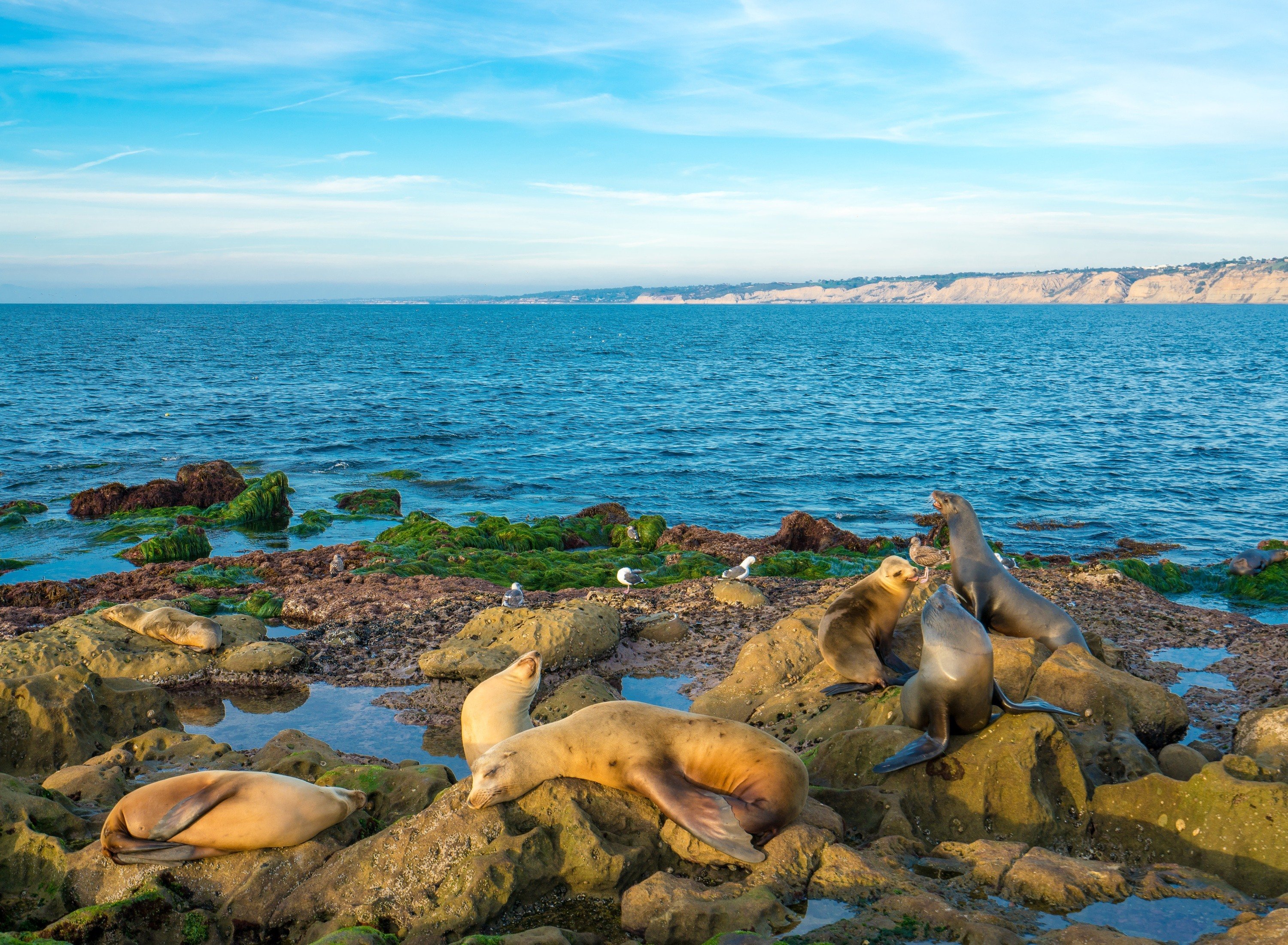












Katie Dillon is the managing editor of La Jolla Mom. She helps readers plan San Diego vacations through her hotel expertise (that stems from living in a Four Seasons hotel) and local connections. Readers have access to exclusive discounts on theme park tickets (like Disneyland and San Diego Zoo) and perks at luxury hotels worldwide through her. She also shares insider tips for visiting major cities worldwide, like Hong Kong, London, Paris, and Shanghai, that her family has either lived in or visits regularly (or both).
Planning a Trip to San Diego? Start Here!
And, don’t forget to save money on sightseeing with my discount tickets or a Go San Diego Card.
Things to Do
Hotels
Before You Go
Explore More in La Jolla
La Jolla Museums: Explore Our Art, Local History, & Sea Life
How to Get to La Jolla, California: Guide to Public Transportation & Directions
18 Best La Jolla Breakfast & Brunch Spots: A Resident’s Restaurant Guide
Expert Tips for Visiting La Jolla Tide Pools & Where to Go
Explore More Things to Do in San Diego
15 Things to Do for Easter in San Diego (2024) from Bunnies to Brunches
SEA LIFE Aquarium at LEGOLAND: Things to Do, Tickets, and Tips
25 Fun Things to Do at the Carlsbad Flower Fields
25 Best Things to Do in Carlsbad Now: A Local’s Guide to Fun Activities